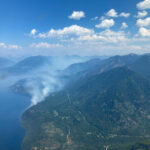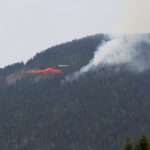BC quietly grants Mount Polley permit to pipe mine waste directly into Quesnel Lake
This article is from DeSmog Canada, written by Carol Linnit.
The B.C. Ministry of Environment has quietly granted the Mount Polley Mining Corporation permission to drain mining waste directly into Quesnel Lake, B.C.’s deepest fjord lake and a source of drinking water for residents of Likely, B.C., as part of a “long-term water management plan.”
The wastewater discharge permit comes nearly three years after the collapse of the Mount Polley mine tailings pond spilled an estimated 25 million cubic metres of mining waste into Quesnel Lake, in what is considered the worst mining disaster in Canadian history.
No charges and no fines have been laid for the spill that cost B.C. taxpayers an estimated $40 million in cleanup costs and that B.C.’s chief mine inspector, Al Hoffman, found was the result of “poor practices” and “non-compliances.”
Some critics feel the new wastewater discharge permit simply grants Mount Polley the permission to continue polluting Quesnel Lake.
“The permit really adds insult to injury,” said Nikki Skuce, project director for Northern Confluence, an initiative based out of Smithers that aims to improve land-use decisions in B.C.’s salmon watersheds.
“Mount Polley still hasn’t cleaned the initial spill up. It’s still visible there in the lake,” Skuce said.
The permit grants Mount Polley, owned by Imperial Metals, permission to release diluted wastewater collected in the mine’s drainage ditches to be piped deep into Quesnel Lake 45 metres below the surface.
“To the layperson that might sound okay, but in digging down deeper what Imperial Metals asked for was for a huge increase in the amount of heavy metals, like selenium, copper, arsenic and others, they can release into the lake,” Skuce said.
“They come up with this plan and it’s to continue pollution, to allow for long-term pollution to go into Quesnel Lake.”
“We’re only two years into the disaster and it is not clear what the impacts are. Salmon run in four year cycles and yet they’re permitting more pollution.”
Article by Carol Linnit from DeSmog Canada published with permission. Editor’s note: The permit granted by the BC government on April 7, 2017, allows the mine to pipe an average of 29,000 cubic metres per day into Quesnel Lake, with a maximum discharge per day of 52,000 cubic metres, and the permit allows the dumping until December 31, 2022.






















